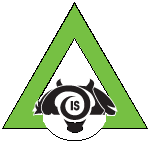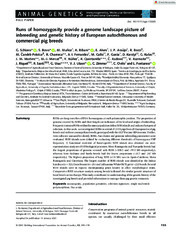Приказ основних података о документу
Runs of homozygosity provide a genome landscape picture of inbreeding and genetic history of European autochthonous and commercial pig breeds
| dc.creator | Schiavo, Giussepina | |
| dc.creator | Bovo, Samuele | |
| dc.creator | Munoz, Maria | |
| dc.creator | Ribani, Anisa | |
| dc.creator | Alves, Estefania | |
| dc.creator | Araujo, Jose P. | |
| dc.creator | Bozzi, Riccardo | |
| dc.creator | Čandek-Potokar, Marjeta | |
| dc.creator | Charneca, Rui | |
| dc.creator | Fernandez, Ana I. | |
| dc.creator | Gallo, Maurizio | |
| dc.creator | Garcia, Fabian | |
| dc.creator | Karolyi, Danijel | |
| dc.creator | Kušec, Goran | |
| dc.creator | Martins, Jose Manuel | |
| dc.creator | Mercat, Marie-Jose | |
| dc.creator | Nunez, Yolanda | |
| dc.creator | Quintanilla, Raquel | |
| dc.creator | Radović, Čedomir | |
| dc.creator | Razmaite, Violeta | |
| dc.creator | Riquet, Juliette | |
| dc.creator | Savić, Radomir | |
| dc.creator | Usai, Graziano | |
| dc.creator | Utzeri, Valerio J. | |
| dc.creator | Zimmer, Christoph | |
| dc.creator | Ovilo, Cristina | |
| dc.creator | Fontanesi, Luca | |
| dc.date.accessioned | 2023-10-25T10:53:08Z | |
| dc.date.available | 2023-10-25T10:53:08Z | |
| dc.date.issued | 2021-04 | |
| dc.identifier.issn | 0268-9146 | |
| dc.identifier.uri | http://r.istocar.bg.ac.rs/handle/123456789/925 | |
| dc.description.abstract | ROHs are long stretches of DNA homozygous at each polymorphic position. The proportion of genome covered by ROHs and their length are indicators of the level and origin of inbreeding. Frequent common ROHs within the same population define ROH islands and indicate hotspots of selection. In this work, we investigated ROHs in a total of 1131 pigs from 20 European local pig breeds and in three cosmopolitan breeds, genotyped with the GGP Porcine HD Genomic Profiler. PLINK software was used to identify ROHs. Size classes and genomic inbreeding parameters were evaluated. ROH islands were defined by evaluating different thresholds of homozygous SNP frequency. A functional overview of breed-specific ROH islands was obtained via overrepresentation analyses of GO biological processes. Mora Romagnola and Turopolje breeds had the largest proportions of genome covered with ROH (~1003 and ~955 Mb respectively), whereas Nero Siciliano and Sarda breeds had the lowest proportions (~207 and 247 Mb respectively). The highest proportion of long ROH (>16 Mb) was in Apulo-Calabrese, Mora Romagnola and Casertana. The largest number of ROH islands was identified in the Italian Landrace (n=32), Cinta Senese (n=26) and LithuanianWhite Old Type (n=22) breeds. Several ROH islands were in regions encompassing genes known to affect morphological traits. Comparative ROH structure analysis among breeds indicated the similar genetic structure of local breeds across Europe. This study contributed to understanding of the genetic history of the investigated pig breeds and provided information to manage these pig genetic resources. | sr |
| dc.language.iso | en | sr |
| dc.publisher | Blackwell Publishing Ltd | sr |
| dc.relation | info:eu-repo/grantAgreement/EC/H2020/634476/EU// | sr |
| dc.rights | openAccess | sr |
| dc.rights.uri | https://creativecommons.org/licenses/by/4.0/ | |
| dc.source | Animal Genetics | sr |
| dc.subject | autozygosity | sr |
| dc.subject | population genomics | sr |
| dc.subject | selection signature | sr |
| dc.subject | single nucleotide polymorphism | sr |
| dc.subject | sus scrofa | sr |
| dc.title | Runs of homozygosity provide a genome landscape picture of inbreeding and genetic history of European autochthonous and commercial pig breeds | sr |
| dc.type | article | sr |
| dc.rights.license | BY | sr |
| dc.citation.volume | 52 | |
| dc.citation.spage | 155 | |
| dc.citation.epage | 170 | |
| dc.identifier.doi | 10.1111/age.13045 | |
| dc.identifier.fulltext | http://r.istocar.bg.ac.rs/bitstream/id/4394/bitstream_4394.pdf | |
| dc.type.version | publishedVersion | sr |


